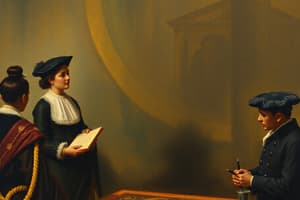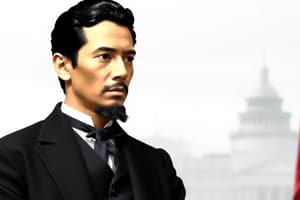Podcast
Questions and Answers
What main objective does Senator Jose P. Laurel highlight as the reason for the Rizal Law?
What main objective does Senator Jose P. Laurel highlight as the reason for the Rizal Law?
- To promote economic growth through the study of Rizal's entrepreneurial ventures.
- To encourage the study of Rizal's life and works, to instill ideals and principles for which he lived and died. (correct)
- To ensure all schools adhere to a standardized curriculum focusing on Spanish colonial history.
- To provide a comprehensive biography of Rizal, focusing primarily on his personal relationships.
What is the primary aim of teaching the Rizal course in the Philippines?
What is the primary aim of teaching the Rizal course in the Philippines?
- To promote proficiency in Spanish language and literature.
- To train students in historical research methodologies.
- To encourage the youth to dedicate their lives to ideals of freedom and nationalism. (correct)
- To prepare students for careers in government and public service.
According to the material, what is one of the goals in teaching the Rizal course?
According to the material, what is one of the goals in teaching the Rizal course?
- To prepare students for overseas employment.
- To promote technological innovation and entrepreneurship.
- To encourage the development of moral character, personal discipline, citizenship and vocational efficiency among Filipino youth. (correct)
- To train students to become proficient in various sports.
According to Constantino (1969), why was Rizal chosen as the national hero of the Philippines?
According to Constantino (1969), why was Rizal chosen as the national hero of the Philippines?
According to Guerrero (1998), why did Filipinos choose Rizal as their national hero?
According to Guerrero (1998), why did Filipinos choose Rizal as their national hero?
What political system was implemented in Spain during the 19th century to address political instability?
What political system was implemented in Spain during the 19th century to address political instability?
What economic policy did Spain abandon in the 19th century, leading to the opening of the Philippines to world commerce?
What economic policy did Spain abandon in the 19th century, leading to the opening of the Philippines to world commerce?
What event directly resulted from Spain's abandonment of mercantilism?
What event directly resulted from Spain's abandonment of mercantilism?
What power did the governor-general possess in the Philippines during Rizal's time due to the lack of a lawmaking body?
What power did the governor-general possess in the Philippines during Rizal's time due to the lack of a lawmaking body?
What was the function of the 'cabeza de barangay' during the Spanish colonial period?
What was the function of the 'cabeza de barangay' during the Spanish colonial period?
What was the 'Audiencia Real' in the Philippines during the Spanish colonial era?
What was the 'Audiencia Real' in the Philippines during the Spanish colonial era?
What was the 'residencia' in the context of Spanish colonial administration in the Philippines?
What was the 'residencia' in the context of Spanish colonial administration in the Philippines?
What term did Lopez Jaena use to describe the situation where friars became so powerful that even civil authorities feared them?
What term did Lopez Jaena use to describe the situation where friars became so powerful that even civil authorities feared them?
In the social structure of the Philippines during the Spanish colonial period, who were the 'peninsulares'?
In the social structure of the Philippines during the Spanish colonial period, who were the 'peninsulares'?
What was the 'polo y servicio' during the Spanish colonial period in the Philippines?
What was the 'polo y servicio' during the Spanish colonial period in the Philippines?
What was a key provision of the Educational Decree of 1863 in the Philippines?
What was a key provision of the Educational Decree of 1863 in the Philippines?
What was a notable weakness of the educational system implemented by the Spanish in the Philippines during the 19th century?
What was a notable weakness of the educational system implemented by the Spanish in the Philippines during the 19th century?
What was a significant consequence of the economic prosperity in the Philippines during the 19th century?
What was a significant consequence of the economic prosperity in the Philippines during the 19th century?
What factor contributed to the Spanish colonial administration's corruption and inefficiency in the Philippines?
What factor contributed to the Spanish colonial administration's corruption and inefficiency in the Philippines?
What impact did European education have on Filipinos from wealthy families during the 19th century?
What impact did European education have on Filipinos from wealthy families during the 19th century?
Flashcards
Republic Act 1425
Republic Act 1425
Republic Act 1425, also known as the Rizal Law, mandates the teaching of Rizal's life, works, and writings in all Philippine schools.
Renato Constantino's view
Renato Constantino's view
Constantino claims the Taft Commission, not Filipinos, chose Rizal as the national hero, backed by American agenda.
Guerrero's view
Guerrero's view
Guerrero asserts Filipinos chose Rizal for his symbolism of nationalism, peace, virtue, and sacrifice.
19th Century Spain
19th Century Spain
Signup and view all the flashcards
Mercantilism
Mercantilism
Signup and view all the flashcards
Governor-General
Governor-General
Signup and view all the flashcards
Alcadias
Alcadias
Signup and view all the flashcards
Pueblos
Pueblos
Signup and view all the flashcards
Barangay
Barangay
Signup and view all the flashcards
Audiencia Real
Audiencia Real
Signup and view all the flashcards
Residencia
Residencia
Signup and view all the flashcards
limpieza de sangre
limpieza de sangre
Signup and view all the flashcards
Peninsulares
Peninsulares
Signup and view all the flashcards
Polo y servicio
Polo y servicio
Signup and view all the flashcards
Educational Decree of 1863
Educational Decree of 1863
Signup and view all the flashcards
Study Notes
Republic Act 1425 (Rizal Law)
- Mandates the teaching of Rizal's life, works, and writings in all Philippine schools.
- Senator Jose P. Laurel sponsored the law. -Reading and studying Rizal, Filipino youth will gain incorruptible confidence, direction, courage and determination.
Objectives in Teaching Rizal Course
- Rededicate the lives of the youth to freedom and nationalism.
- Pay tribute to Rizal for shaping the Filipino character.
- Gain an inspiring source of patriotism through studying Rizal.
Goals in Teaching Rizal Course
- Recognize the relevance of Rizal's ideals to present conditions.
- Apply Rizal's ideas to solve contemporary problems.
- Develop an understanding and appreciation of Rizal's qualities and character.
- Foster moral character, personal discipline, citizenship, and vocational efficiency among Filipino youth.
Who Chose Rizal as the National Hero?
- Constantino (1969) claims Rizal was an American-sponsored hero chosen by the Taft Commission of 1901.
- Potential heroes included Rizal, Aguinaldo, Bonifacio, and Mabini.
- Act No. 137 organized a politico-military district and named it Rizal province.
- Act No. 243 authorized a public subscription for a Rizal monument in Luneta.
- Act No. 345 designated the anniversary of Rizal's death as a day of observance.
- Agoncillo (1986) states Rizal was a symbol of assimilation, matching American policy.
- Constantino (1969) notes Rizal was dead during American aggression, had no anti-American quotes, and his martyrdom symbolized Spanish oppression.
- Guerrero (1998) asserts Filipinos chose Rizal before his death, viewing his martyrdom as spiritual dominion.
- Filipinos chose Rizal due to their love for peace, freedom, justice, virtue, and sacrifice.
Spain in the 19th Century
- The 19th century was a turbulent period in Spanish politics due to frequent changes in ministries and constitutions (Zaide, 1994).
- The Spanish crown introduced the Canovite system or rotativism (Maguigad et al, 2000).
- Spain abandoned mercantilism and adopted the laissez-faire policy.
- Mercantilism is an economic doctrine measuring wealth and power by gold and silver stock.
- Spain ended the Galleon Trade or the Manila-Acapulco trade in 1873.
The Philippines During Rizal's Time: Administrative Organization
- The Governor-General, appointed by the Spanish monarch, headed the Spanish colonial government.
- Also the Vice Royal Patron and commander in chief.
- The Governor-General was ex-officio president of the Royal Audiencia.
- The governor-general had legislative powers.
- Actos acordados (Maguigad, 2000) are laws enacted by the governor-general.
- Cumplase is the power of the governor-general to decide which laws to enforce.
Administrative Organization
- Local government units: alcadias, pueblos, and barangays (Agoncillo, 1990).
- Alcadias: provinces headed by an alcalde mayor.
- Alcalde mayors had executive and judicial functions.
- Illicit trade: indulto de commercio.
- Pueblos: towns headed by a gobernadorcillo
- Principal responsibility: tax collection.
- Barangay: smallest unit headed by a cabeza de barangay (Romero et al, 1978).
- Main function: maintaining peace and order and tax collection.
- Ayuntamiento: city government during the Spanish Regime (Zaide, 1994).
- Governed by a cabildo or city council: city mayor (alcalde en ordinario), councilors (regidores), constable (aguacil mayon), and a secretary (escribano).
- Eventually, friars gained enough power to be feared by the civil authorities, termed frailocracia by Lopez Jaena.
- Control tightened through the friars to keep control of the Philippines.
- The Guardia Civil was organized in 1867 as native police under Spanish officers.
- In 1880, the civil guard was used for summary arrests of filibusteros and erehes.
- The Audience Real had Judicial power: the Supreme Court during Spanish rule (De Leon, 2000).
- Below the Audiencia Real were two territorial audiencias, courts of first instance, and justice of the peace courts.
- The Audiencia Real adjudicated appeals for civil and criminal cases
- It also served as a forum for settling important issues on governance and an auditing agency of the finances of Spanish colonial administration in the country.
- No legislature existed in the Philippines before the United States took over in 1898 with previous represenation abolished in 1837 (Schumacher, 1997).
- Las Leyes de Indias remained the basic law but gradually modified.
- Colonial administration was corrupt and inefficient due to the distance from Spain.
- Governor-Generals could reward unqualified favorites.
- The Spanish Crown instituted the residencia, and visitador.
- Lower positions were sold to the highest bidders.
- Graft and corruption were rampant.
The Social Structure of Filipino Society
- Philippine society was feudalistic due to the encomienda system (Romero et al, 1978).
- Filipinos were treated as slaves who had to render polo y servicio, or forced labor to the government and church.
- The social hierarchy was based on limpieza de sangre, purity of blood (Maguigad, 2000).
- The social pyramid consisted of the peninsulares at the apex, then the insulares, Spanish and Chinese mestizos, and principalia.
- At the bottom were the Indios.
Educational System
- The Educational Decree of 1863 implemented one elementary school for boys and girls.
- The decree provided a normal school for teachers familiar with the Spanish language.
- All schools were to use Spanish language.
- Notable weaknesses of the education system (Romero et al, 1978):
- Overemphasis on religion.
- Limited and irrelevant curriculum.
- Obsolete classroom facilities.
- Inadequate instructional materials.
- Absence of academic freedom.
- Racial prejudice against Filipinos in the school.
Economic Situation
- The country was opened to foreign trade at the end of the 18th century.
- Foreign firms in Manila rapidly increased.
- Agriculture and export of sugar, rice, hemp, and tobacco saw expansion.
- Increased trade increased contact with foreigners and spaniards (Schumacher, 1997).
- Increased trade aided families, who sent their sons to get an education in Europe.
- Filipino scholars, were able to absorb intellectual European ideas.
- This gave them awareness of a society and made them disenchanted with Spain.
Studying That Suits You
Use AI to generate personalized quizzes and flashcards to suit your learning preferences.




